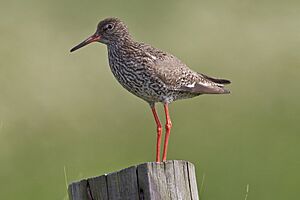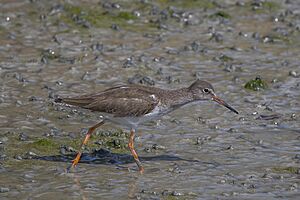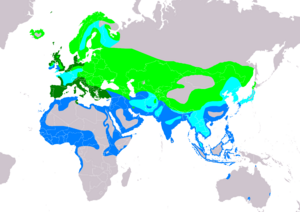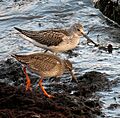Common redshank facts for kids
Quick facts for kids Common redshank |
|
|---|---|
 |
|
| Breeding plumage | |
 |
|
| Non-breeding (winter) plumage | |
| Conservation status | |
| Scientific classification | |
 |
|
| Range of the common redshank Breeding Resident Passage Non-breeding | |
| Synonyms | |
|
The common redshank, also known as just redshank, is a type of bird that lives in Europe and Asia. It is a wader, which means it's a bird that likes to walk in shallow water. Redshanks belong to a big bird family called Scolopacidae.
Contents
About the Redshank's Name
Scientists give every animal a special two-part name. This helps everyone around the world know exactly which animal they are talking about. The common redshank's scientific name is Tringa totanus.
A famous Swedish scientist named Carl Linnaeus first officially described this bird in 1758. He gave it the name Scolopax totanus. Later, it was moved into a group of birds called Tringa. The name Tringa comes from an old Italian name for a similar wading bird. The second part of its name, totanus, also comes from an Italian word for this bird.
There are six different types, or subspecies, of the common redshank:
- T. t. robusta: These birds breed in Iceland and the Faroe Islands. They spend their winters around the British Isles and western Europe.
- T. t. totanus: This type breeds across western and northern Europe all the way to western Siberia. They fly to Africa, India, and Indonesia for the winter.
- T. t. ussuriensis: These redshanks breed in southern Siberia, Mongolia, and eastern Asia. They spend their winters in Africa, India, and Southeast Asia.
- T. t. terrignotae: You can find these breeding in southern Manchuria and eastern China. They winter in East and Southeast Asia.
- T. t. craggi: This type breeds in northwest China. They also spend their winters in East and Southeast Asia.
- T. t. eurhina: These redshanks breed in Tajikistan, northern India, and Tibet. They winter in India and the Malay Peninsula.
What Does a Redshank Look Like?
Common redshanks change their look a bit depending on the season. When they are ready to breed, their feathers are a marbled brown color, a little lighter on their belly. In winter, they become lighter and less patterned. They look more plain greyish-brown on top and whitish underneath.
All redshanks have bright red legs and a red bill with a black tip. When they fly, you can see white patches on their back and wings.
There's another bird called the spotted redshank. It breeds in the Arctic and looks a bit different. It has a longer bill and legs. In breeding season, it's almost completely black, but in winter, it's very pale. The common redshank is actually more closely related to the marsh sandpiper and the smaller wood sandpiper. These birds often have red or yellowish legs.
Where Do Redshanks Live?
The common redshank breeds across many parts of Europe and Asia. They are migratory birds, which means they travel long distances. They spend their winters on coasts around the Mediterranean Sea, along the Atlantic coast of Europe (from Ireland and Great Britain southwards), and in South Asia.
Sometimes, a redshank might fly far off course and end up in a place it doesn't usually visit. For example, a redshank was seen in Palau in Micronesia in the 1970s and again in 2000. Also, a tagged redshank was spotted in a bird sanctuary in Tamil Nadu, India, in April 2021.
Redshank Behavior
Redshanks are known for being watchful and noisy birds. If they sense danger, they will make a loud piping call. This call warns other birds and animals nearby.
Where Redshanks Lay Eggs
Redshanks build their nests in many different wet areas. This can be damp meadows or even salty marshes near the sea. They often nest close to each other. A female redshank usually lays between three and five eggs.
What Redshanks Eat
Like most waders, redshanks eat small invertebrates. These are tiny creatures without backbones, like worms and insects, which they find in the mud or shallow water.
Redshank Status
The common redshank is found in many places and there are quite a lot of them in some areas. Because of this, it is not considered an endangered species by the IUCN, which is a group that checks on wildlife. The common redshank is also part of an agreement called the Agreement on the Conservation of African-Eurasian Migratory Waterbirds (AEWA). This agreement helps protect birds that migrate between Africa and Eurasia.
Gallery
-
The common redshank is much smaller than the Common greenshank.







